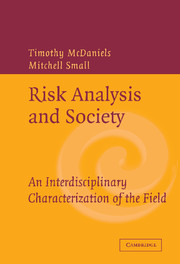Book contents
- Frontmatter
- Contents
- Contributors
- 1 Introduction – Risk Anaysis and Society: An Interdisciplinary Characterization of the Field
- PART ONE FUNDAMENTAL CHARACTER OF RISK
- PART TWO METHODS FOR RISK ASSESSMENT
- 6 Uncertain Risk: The Role and Limits of Quantitative Assessment
- 7 Valuing Risk Management Choices
- 8 The Role of Efficiency in Risk Management
- PART THREE NEW APPROACHES AND NEEDS FOR RISK MANAGEMENT
- SUMMARY AND FUTURE DIRECTIONS
- Index
- References
6 - Uncertain Risk: The Role and Limits of Quantitative Assessment
Published online by Cambridge University Press: 05 June 2012
- Frontmatter
- Contents
- Contributors
- 1 Introduction – Risk Anaysis and Society: An Interdisciplinary Characterization of the Field
- PART ONE FUNDAMENTAL CHARACTER OF RISK
- PART TWO METHODS FOR RISK ASSESSMENT
- 6 Uncertain Risk: The Role and Limits of Quantitative Assessment
- 7 Valuing Risk Management Choices
- 8 The Role of Efficiency in Risk Management
- PART THREE NEW APPROACHES AND NEEDS FOR RISK MANAGEMENT
- SUMMARY AND FUTURE DIRECTIONS
- Index
- References
Summary
INTRODUCTION
The assessment and management of uncertain risks is an essential component of science, engineering, medicine, business, law, and other modern disciplines. I. Good argues that risk science based on the evaluation of probabilistic events has been useful in saving and improving lives throughout history, “since the assessment of uncertainty incorporates the idea of learning from experience which most creatures do” (Good, 1959). Learning from experience is only part of the challenge, since many decisions involve new or evolving risk scenarios in which humans have little or no experience. Risk management capabilities must include the ability to respond to risks that are known and well understood, and the ability to detect and anticipate those that are newly emerging (e.g., U.S. EPA SAB, 1995; NRC, 1999; U.S. EPA ORD, 2000). Uncertainty analysis provides a framework for characterizing the position of a problem along this continuum and the implications for appropriate response and management.
Uncertainty about risk arises as a result of a fundamental lack of understanding about how the world works, randomness in the outcome of natural and human processes, and an inability to measure, characterize, or even at times define key quantities of interest that affect, or are affected by, risk. Risks can vary across time, space, and from individual to individual in a population. Characterization of these variations is an essential part of a risk analysis; however, the basic knowledge or data to fully and effectively characterize risk, and its variability, are often lacking.
- Type
- Chapter
- Information
- Risk Analysis and SocietyAn Interdisciplinary Characterization of the Field, pp. 163 - 212Publisher: Cambridge University PressPrint publication year: 2003
References
- 1
- Cited by



